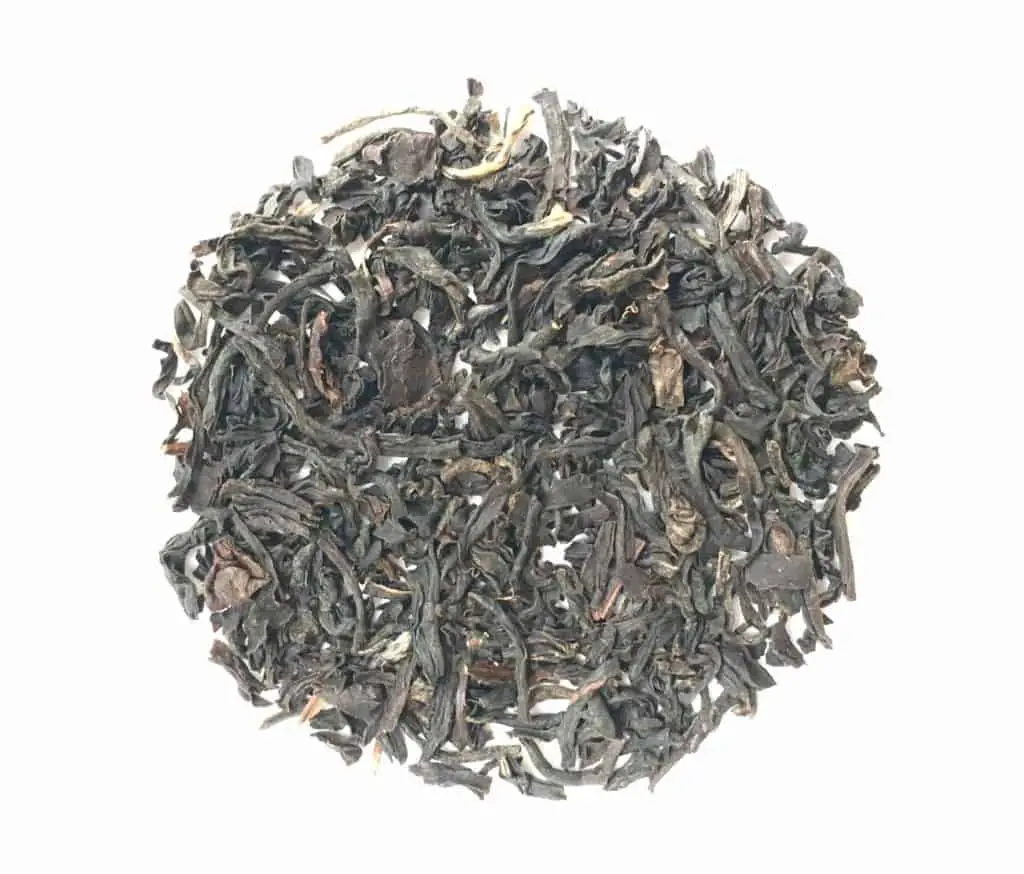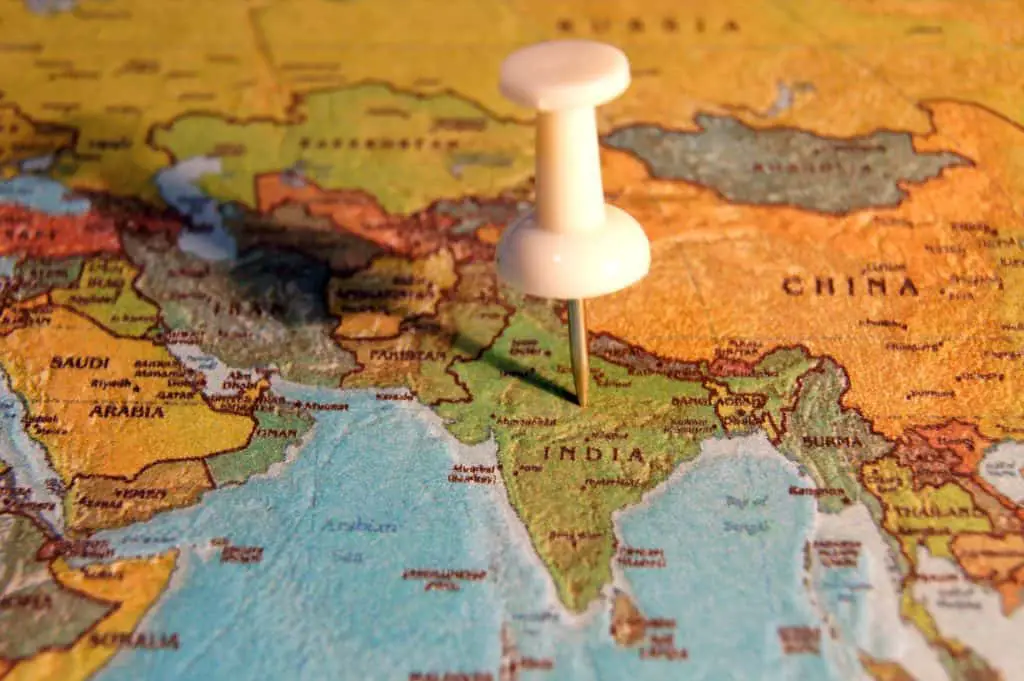
They say in real estate that the three keys to success are location, location, and location.
In the world of tea, a similar principle holds: where tea is grown matters; it matters a lot!
To drink tea is to take in the soil, climate, geology, and human cultural history of the region where your tea was grown and manufactured.
Even though the tea plant, Camellia sinensis, is one factor shared among the different tea-growing regions, there are local variations in both the plant and farming practices that contribute to each region’s uniqueness.
Indeed, one of the joys of drinking tea is the chance to explore the nooks and crannies of local tea culture.
Each sip of tea is one step closer to a distant and exotic land.
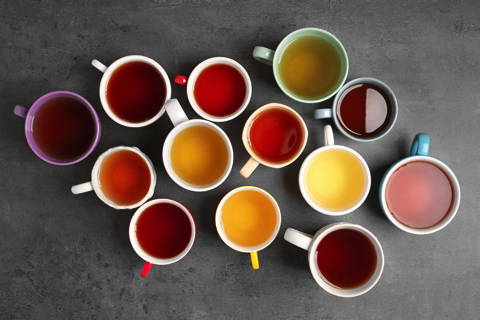
Table of Contents
- So Many Tea Journeys, So Little Time (and Money)
- The First Steps On Your Tea Journey to India
- First Stop: Assam, Home of Bold and Malty Black Tea
- Assam Black Tea: Our Recommendations
- #1. Assam Black Tea for Every Day: Organic Positively Tea Co. Assam Black Tea
- #2. Pour to Impress: Assam Premium Black Tea by Vahdam Tea
- But Wait! There’s More from Assam
- Next Stop: Darjeeling Tea and the Lightness of the Highlands
- Darjeeling Tea: Our Recommendations
- #1. Darjeeling First Flush (Spring) Tea by Vahdam Tea
- #2. Darjeeling Late Season (Autumn) Flush Black Tea by Golden Moon Tea
- #3. A New Arrival to Darjeeling: Tapas Oolong Tea by Teamonk Global
- Last Stop: Nilgiri Tea, Up a Different Mountain Path
- Nilgiris Tea recommendation: A Fresh, Low-Caffeine, Nilgiri White Tea by Teabox
- There’s More Indian Tea to Discover!
- Summary of Recommendations: One Last Nudge
- Teawares That You Need: Tea Strainer/Tea Infuser
So Many Tea Journeys, So Little Time (and Money)
As with many journeys, however, it is sometimes difficult to know where to begin, which direction to turn, and which alley to take.
Resources for your tea journey are limited, and you worry about making a mistake and pouring your hard-earned cash down the drain.
And in a world where there are endless choices, the path forward is not always obvious.
Here at Leaf House Tea, we suggest two systems of tea exploration:
- Pick a tea type and then find that type among each of several tea regions. For example, explore green teas produced among many different regions.
- Pick a region and explore the teas crafted within that particular region.
Either system may transform you into an informed and happy tea drinker who has embarked upon a life-long tea journey!
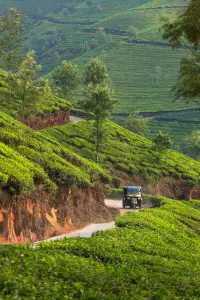
The First Steps On Your Tea Journey to India
In today’s post, you and I are going to follow system #2 and embark on a journey to India, a vast nation-state with a vibrant and storied history in tea.
However, India is so enormous and the tea so richly variable that we must further subdivide this nation into the following tea districts: Assam, Darjeeling, and Nilgiri.
This is an introduction and not intended to be a deep dive into Indian tea culture. Indeed, there are seven officially recognized tea districts in India!
To keep this post manageable, we will first focus on these three better-known districts and explore the tea offerings of each one. By the end, you will have the information you need to take the first steps on your journey.
Along the way, I review and recommend excellent Indian teas that will sustain you during your travels. Scroll down if you want to jump ahead to the reviews.
India is Home of the Modern Tea Industry
China may be the first nation to develop local tea culture, but India is where the industrial tea industry first took flight.
Beginning in the 1840s, during a period of intense interest by British agronomists, there were several Indian developments that made all the difference to the global tea industry:
- cross-pollination of local tea varieties with imported tea to produce hardy plants with copious leaves;
- engineering advances in the field that included improvements in water management and soil conservation;
- introduction of large-scale composting operations to convert organic matter and animal wastes into vital plant nutrients; and
- the invention of factory machinery to perform the arduous work in processing tea.
Entire books are written on these steps in the evolution of Indian tea, but here’s why history matters: Innovations in tea farming and tea manufacture made it possible to grow and process tea across a wide range of Indian environments.
For instance, plant breeders discovered that a large-leaf, Indian variety of tea camellia called assamica performs better in steamy lowlands when hybridized with a small-leaf variety imported from China.
Conversely, the small-leaf variety thrives in the cool highlands, where the Indian variety failed.
And with factory mechanization, huge tea harvests can now be consistently transformed into something worth drinking.
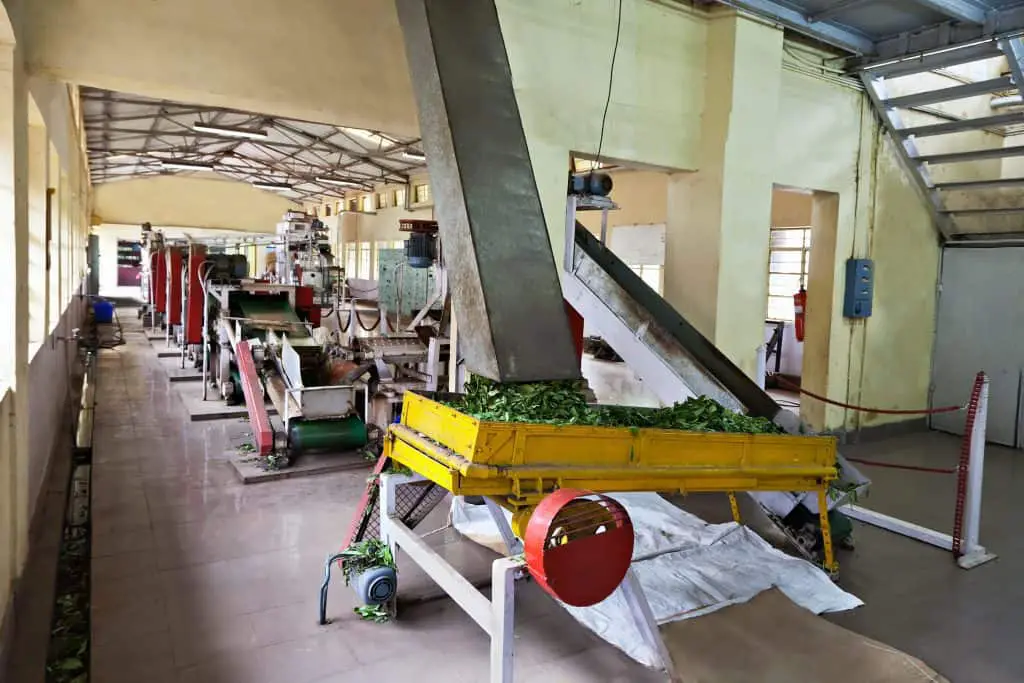
As you will see, these technologies have given rise to a plethora of tea types now manufactured in India.
More still, surplus tea that is not consumed locally is now available for export to foreign lands, like that found in your kitchen cupboard!
These and other innovations of the Indian tea industry have since been adopted the world over. Kenya and Argentina, for example, now have their own tea industries thanks largely to advances first made in India.
Even global tea giant China has adopted important elements of Indian tea technology.
In a very important sense, the modern tea industry owes its prosperity to the tea pioneers of India.
Long live Indian tea!
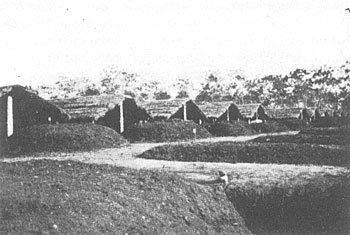
A Trip to Tea India: Where to Begin?
But where there’s so much tea to choose from, there could be reluctance by the tea drinker.
The sheer number of tea-growing districts in India can be overwhelming, and it’s not always clear where one should start on this wonderful journey.
But we’re here to help!
In this article, we offer suggestions regarding different Indian teas that we think cover a range of taste preferences. We think that after you wet your whistle with these recommendations, you will have the confidence to explore Indian tea on your own.
Let’s start by considering tea grown and processed where the Indian industry was born, in the state of Assam. We will then take a trip to the famously romantic township of Darjeeling, and finish our travels to a lesser-known, but very special district called Nilgiris.
First Stop: Assam, Home of Bold and Malty Black Tea
Assam is located in the extreme north-eastern reach of the country and is split down the middle by the massive Brahmaputra River. The assamica variety of tea occurs here natively, and its cultivated descendants have been carefully hybridized and selected for mass propagation.
Monsoon rains, rather than seasonal cold, shape Assam’s growing and harvest seasons. This is important because tea grown in areas without a winter dormant period is often better suited for the production of black teas than other types, such as green tea.
When it’s not raining, Assam is very hot, with temperatures often reaching 95 degrees Fahrenheit (35 Celsius) or higher. Tea growers have learned that planting shade trees among the tea can reduce the harshness imparted to tea leaves during stressful spells of high ambient temperatures.
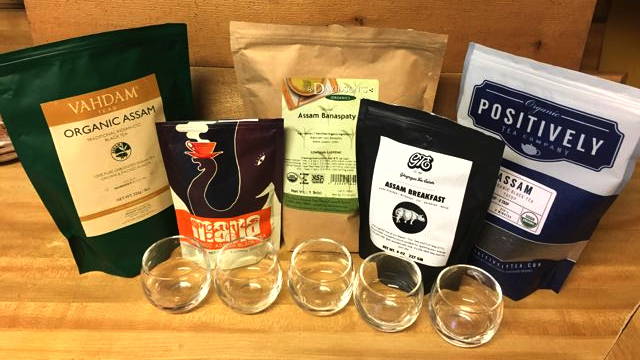
What’s Assam tea?
Heavy rainfall, deep and fertile soil and almost year-around plant growth contribute to making Assam famous for black teas that are bold and stout.
The strength of Assam black tea also emerges as thick red liquor (i.e., the part you drink) that leaves a pleasantly astringent feeling on the tongue and palate.
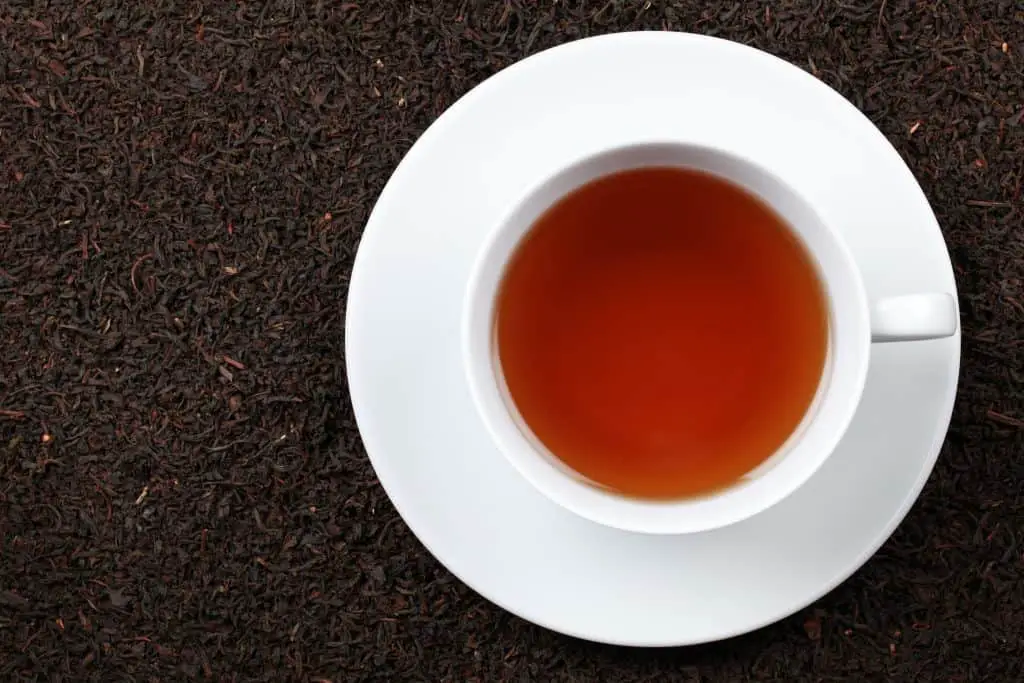
The other remarkable feature of Assam black teas is maltiness. This is the flavor sensation that you might experience from bread or sweet potatoes that are baked to the point of being almost burnt but not ruined.
Part of the malty character comes from Assam’s soils and climate, or terroir. At the same time, a skilled tea maker can bring out the maltiness of tea by raising the oven temperature during the drying stage of tea production.
Have you ever had malted milk chocolate candies? Well, it turns out that combining a malty flavor with milk and sugar is a good idea, a fact that holds true for Assam black teas as well.
Teas that are known as “breakfast teas” take dairy and sweeteners without losing their robustness. Assam black teas are ideal as breakfast teas that are flavored with your favorite dairy creamer (or substitute) and a source of sugar.
And because of their fighting spirit, Assam black teas are also great for kombucha ferments where the fruit and SCOBY might otherwise knock-out less substantial teas.
Does Assam tea have caffeine?
All Assam black teas are naturally caffeinated and the average 8 oz cup of tea will contain about 50 mg of caffeine. That’s on the high end of caffeine content for camellia tea but probably half of what you will drink in an ordinary 8 oz cup of coffee.
Indeed, the feel of Assam black teas in the mouth, along with the strength and the caffeine, lead some to choose this Indian tea variety as a permanent alternative to coffee.
Summary: The benefits of Assam black tea
Here’s what you can expect from a good cup of Assam black tea:
- A stout cup of tea that is as beautiful to look at as it is to drink.
- Strength and maltiness that pairs well with dairy, sweeteners, and chocolate.
- A perfect mate for kombucha ferments.
- A natural caffeine pick-me-up.
- Coffee’s replacement.
Assam Black Tea: Our Recommendations
In my recommendations, I focus on the best value for the price. I will never compromise on flavor, taste, and enjoyment because there is simply no point to drinking bad tea no matter the price.
And since I have crowd-sourced as many reviews as we can find, our recommendations include tea brands that have been put through the tea press, so to speak.
Lastly, I have personally sampled many of the fines teas reviewed here. My goal is to sample them all. And know this: I would never recommend a tea that I did not find enjoyable nor worth the price, no matter how fancy the brand or revered the tea maker.
#1. Assam Black Tea for Every Day: Organic Positively Tea Co. Assam Black Tea
There is no mistaking Positively Tea’s Assam Black Tea for anything other than what it is. This tea is bold and beautiful with all the maltiness that you should expect from Assam tea producers.
Drink it straight or take it at breakfast with milk and sweetener, but either way, this tea is authentic Assam black tea.
And as a bonus, Positively Tea works with Indian tea estates that are USDA certified organic. This means that no pesticides, herbicides, or synthetic fertilizers are used during the farming and manufacture of this black tea.
This full-leaf tea will give the flavor of Assam without any dangerous additives.
Note that teas labeled as “breakfast tea” are often blends of Assam tea with tea from each of several different regions. Positively Tea assures us, however, that their Assam black tea is not blended; it is pure Assam.
The strength and flavor of this tea will make a fine balance in a fruity kombucha concoction.
Combine a quality black tea with a fair price and you have a very nice daily treat straight from Assam.
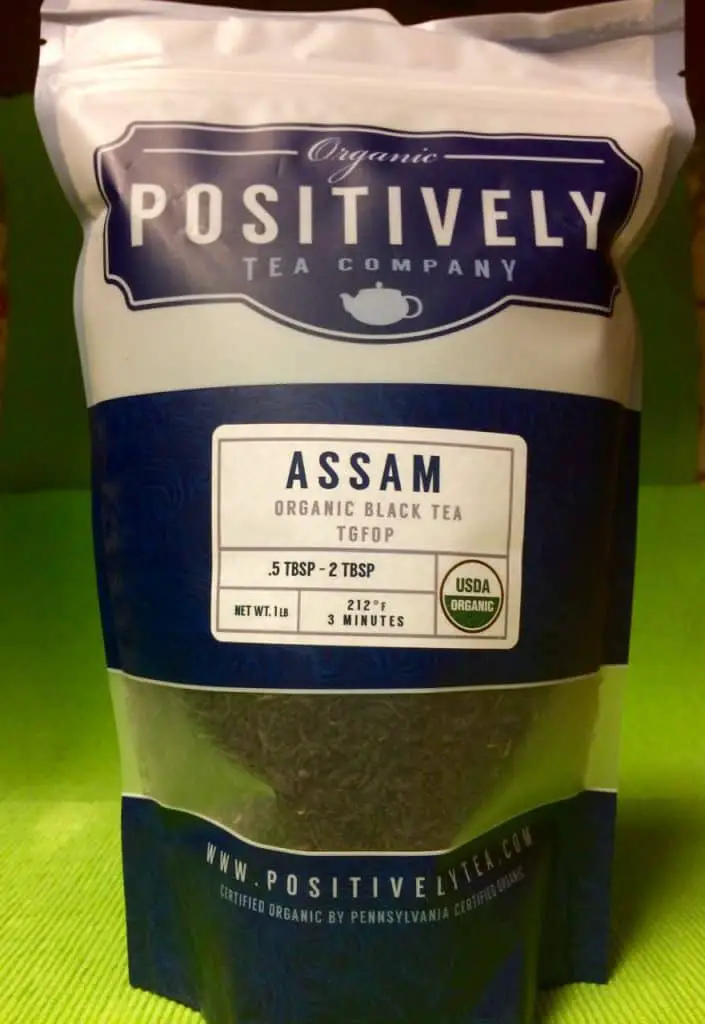
Tea Summary
#2. Pour to Impress: Assam Premium Black Tea by Vahdam Tea
Sometimes you want a black tea that’s really easy on the palate. This is especially true when you are sharing with novice tea drinkers who might be taken aback by a tea with a big, strong flavor.
Times such as these are when you need a black tea that goes down smooth and easy and without bitterness. Now that’s a challenge for Assam black teas which have stoutness and strength as two of its signature qualities.
But we think that we have found such a tea and it is a Premium Organic Assam Black Tea by Vahdam Tea Company. Their Assam tea is manufactured into cut, tear, and curl (CTC) pellets which is a form of finished tea leaf that is largely exclusive to India.
This black tea has a smooth mouthfeel and a silky finish. Reviewers say that maltiness is not pronounced here but we think that is a fair trade-off for a tea that has a nice earthy note without bitterness.
Your newbie tea friends will appreciate that you’ve served them an Assam black tea that doesn’t make the hair on their necks stand up!
In my own tastings, I have discovered that the Vahdam’s Premium CTC pellets release flavor and mouthfeel very quickly into the infusion. I also learned that you can push the tea past its balance point if you steep for longer than three and a half minutes.
Vahdam Tea does other great things with this treat from Assam. They have not only certified their producer’s leaf as USDA organic, but they also claim that the leaf is sourced from a single estate.
Careful sourcing increases accountability and improves the product.
And finally, Vadham’s teas are fresh. Their goal is to pack all tea within 72 hours after receipt from the tea maker; i.e., the tea does not sit around in a storage facility, going stale. Packed tea is then shipped directly to retailers abroad, thereby eliminating the middlemen.
If you have the budget for a slightly more expensive (but not prohibitive) Assam black tea, then please sample this wonderful offering from Vahdam.
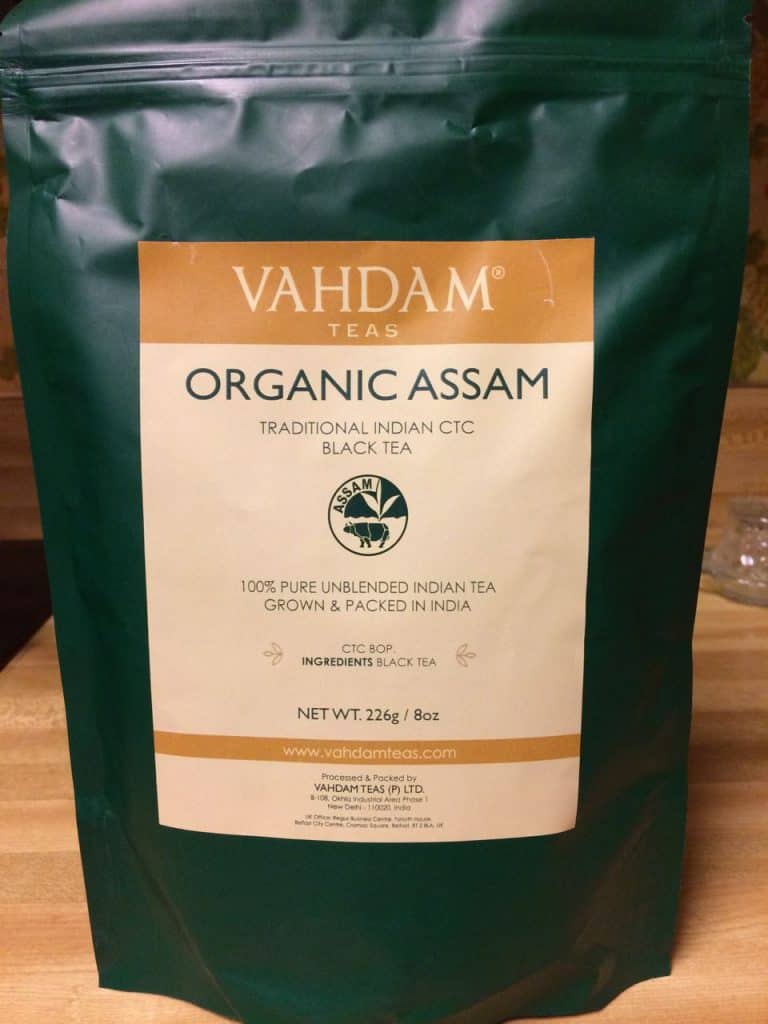
Tea Summary
But Wait! There’s More from Assam
We have written more about the joys of Assam black teas. Lots more!
If you would like to explore the best Assams in many different categories, for example:
- best single-estate Assam tea;
- best organic Assam tea;
- best Assam tea for kombucha;
- and more,
then click here to read our detailed review of the best Assam black teas of the season.
Next Stop: Darjeeling Tea and the Lightness of the Highlands
Just to the east and a little bit north of Assam lies the famed tea district of Darjeeling. But whereas Assam is a lowland tea region, Darjeeling and the surrounding areas are highlands that rub shoulders with the snowy Himalayas.
Tea is cultivated here at altitudes between 3000 feet (920 meters) and 6,500 feet (2000) above sea level.
These are not headache-inducing altitudes, but it does make a difference to tea. For instance, in the higher elevations, there’s a risk of frost so Darjeeling growers prefer the cold-hardy, small-leaf variety of tea camellia.
Seasonal coolness causes a slow-down in plant growth during the winter months. When spring arrives, new growth on the tips of tea branches will flush with young leaf.
Young leaves are often highly prized and there may be a premium paid for teas made from particular leaf flushes.
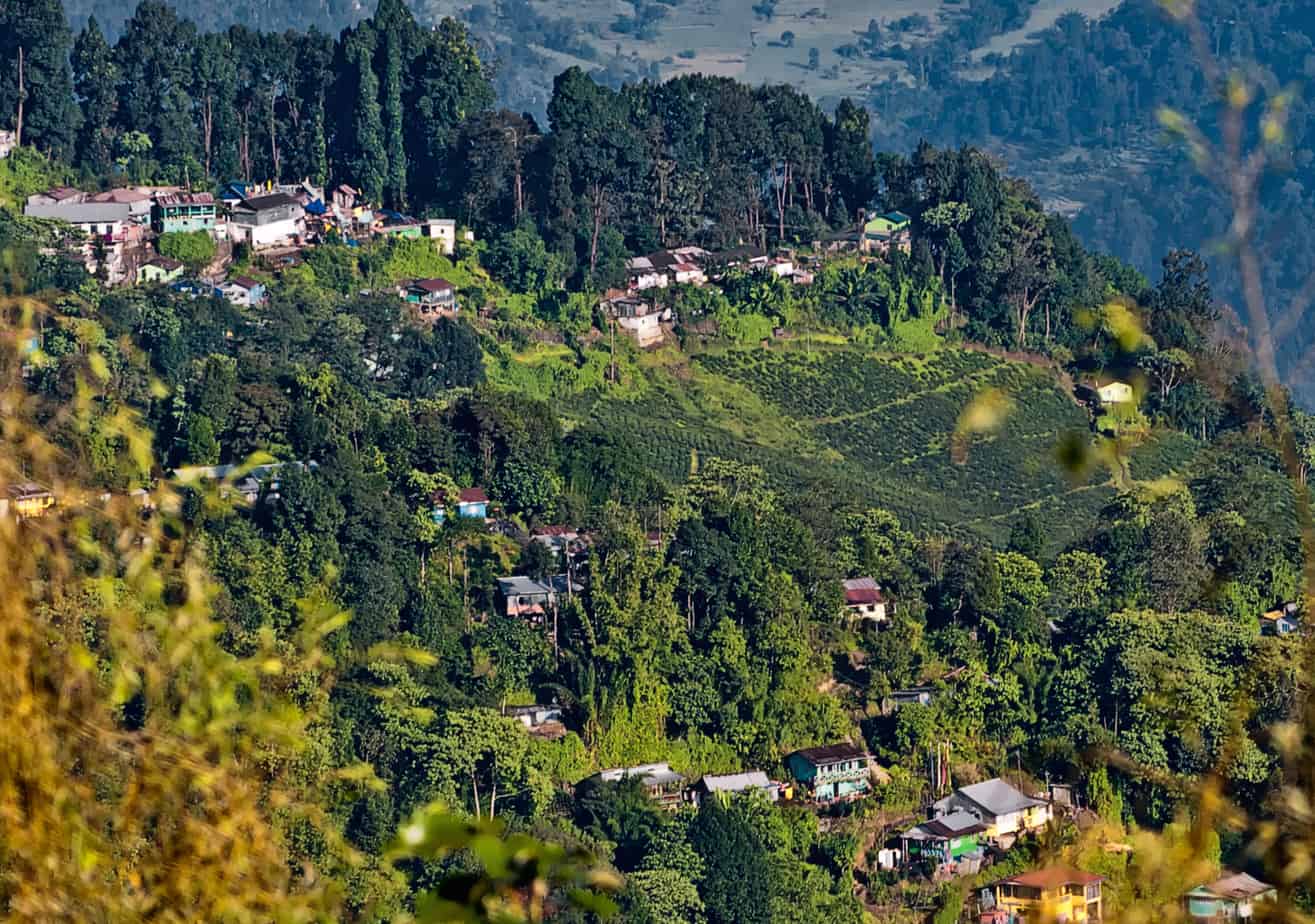
What is Darjeeling Tea?
Darjeeling tea makers long ago discovered that the combination of climate, soils, and tea varietal favor a special tea.
But rather than having the strength and robustness of Assam black teas, the black teas of Darjeeling, particularly leaf of the second flush, is fragrant, floral, and grapey.
Darjeeling black teas are altogether much lighter on their feet than Assam teas. Instead of an Assamese brass band playing on your palate, a fine Darjeeling black tea will playfully dance upon your tastes buds.
The fragrance of a Darjeeling black will first emerge as you inhale the aroma of a freshly poured cup of hot tea. You may not be able to describe the scent at first, but soon a pleasing floral scent will envelop the nose.
The grapey quality shows up toward the finish of the sip and plays on the back of the mouth. There is even a spicy note to the grape that adds a bit of zip to the brew.
Teas of the first flush are even more sublime. Here the tea maker may allow the tender leaf to only partially oxidize and thereby create a product that is more like a green tea or an oolong tea than a black tea.
Partially oxidized teas of Darjeeling have a light-colored liquor and little bitterness or astringency.
Less oxidized teas also contain higher levels of beneficial antioxidants than fully oxidized teas.
The caffeine content of Darjeeling teas varies with the season of harvest and the details of leaf processing. Expect for black teas to have more caffeine (up to 50 mg per cup) than green teas or oolongs.
Your Tour of Darjeeling Tea May Include these Benefits:
- Light-weight black teas with floral notes and fragrance.
- Partially oxidized teas that aren’t quite black tea and aren’t quite green.
- Higher levels of antioxidants than fully oxidized teas.
- Naturally caffeinated.
Darjeeling Tea: Our Recommendations
According to Indian regulation, only tea that is grown within a specially designated district of tea estates can be labeled as Darjeeling tea.
In other words, close is not always close enough in the eyes of the law.
As of this writing, there are only 87 Darjeeling tea gardens that qualify for the government’s Geographic Indication of tea source.
That’s pretty special tea.
Here we aren’t playing any games with sourcing. To make it onto our list, tea growers and manufacturers have to be bona fide Indian businesses that respect the letter and spirit of the law regarding the special status of Darjeeling tea.
Export companies and retailers are of course foreign entities in many instances, but this has no bearing on the special status.
The upside is that you get what you pay for: no funny business. The downside is that you have to pay a bit more.
And so it goes, but the trade-off between authenticity and price is not severe. The teas are great and we think that you’ll be happy with what we recommend.
#1. Darjeeling First Flush (Spring) Tea by Vahdam Tea
Tea made from the first flush of spring leaf should be light but vibrant with grassy notes.
That almost sounds like a green tea, doesn’t it?
In fact, a lot depends on the treatment of the leaf. For example, if the tea maker lets the leaf approach full oxidation then it will take on the color, aroma, and flavor of a black tea.
In the case of Vahdam Tea’s First Flush Darjeeling Tea, it is technically a black tea but it has many qualities of a lightly oxidized green. This special tea really defies easy categorization and who cares about category anyway?
What you get is a tea with a beautiful golden-yellow liquor and hint of citrus flower that hits the nose.
The sip is delicate at the front-end of the mouth but soon a bouquet of floral hints fills the spaces.
The tea finishes clean and leaves you wanting another infusion. And you can get just that.
Those who have sampled this tea report that three separate infusions are possible so long as you use water that is about ten degrees below a boil. In addition, keep the infusions to less than two minutes each in order to stretch out each tea session. This is how you will realize savings when purchasing a higher quality of tea.
As I mentioned in the Assam tea review, Vahdam guarantees the freshness of its teas and has great reviews regarding customer service.
If you want to try a unique and exciting black tea that’s not really a black tea, then this Darjeeling first flush is a great choice.
Tea Summary
#2. Darjeeling Late Season (Autumn) Flush Black Tea by Golden Moon Tea
Grown, processed, and packed at the famed Makaibari Tea Farm, this offering is an excellent choice for those seeking the character of a classic Darjeeling black tea.
Founded in 1859, Makaibari is perhaps the longest operating tea estate and tea manufacturer in India. It is also one of a few to design the estate to integrate with the local ecosystem.
This farming method goes by many labels but Makaibari prefers the term beyond organic. The company explains that beyond organic farming practice not only maintains USDA organic standards but also embraces the principle that the health of a farm’s products is intricately linked to the health of all other species in the system, including the human species.
We presume that Makaibari also has you, the tea drinker, in mind.
But will you notice the difference in the brew?
Tea reviewers report that a floral note is first evident in the aroma wafting above the fresh-poured cup of Makairbari’s black tea. Early into the first sip, a chocolatey flavor arrives that is followed by a grapey feel that makes itself at home on the roof of the mouth.
No, you’re not drinking a cheap wine but rather some of the finest Darjeeling tea out there!
The finish is described as delicate and the mouth is clean and brisk at the end of the cup.
Some tea drinkers like to add a bit of milk to this tea but don’t tell that to a Darjeeling tea maker! Generally, these black teas are taken straight so that all the natural effervescence can be enjoyed.
Makaibari tea is imported by Golden Moon Tea, a company that is serious about eliminating synthetic chemical input from our tea. Each tea that Golden Moon sells has been rigorously sourced through reputable tea farms and tea sellers.
Tea Summary
#3. A New Arrival to Darjeeling: Tapas Oolong Tea by Teamonk Global
Darjeeling is not known for oolong teas. But it turns out that the character of the small-leaf Camellia sinensis variety grown Darjeeling lends to both fully oxidized black teas and partially oxidized teas like oolongs.
And people love their oolong teas so why shouldn’t Darjeeling producers expand into this market?
Well, the main challenge is getting the timing and duration of the oxidation phase for oolongs tea just right. Please believe the amateur tea makers here at Leaf House Tea when we say that oxidation effects can make or break the tea (and possibly the tea maker).
Too little oxidation and you may have a green tea with no character. Too much and you may have a black tea with a bad attitude.
This is why even well-made oolongs have complex flavor profiles that borrow the best from greens and blacks without merely landing somewhere in between the two.
Oolongs can be enigmatic and difficult to describe with mere words. Interpretive dance may be more useful here. In any case, this is why people love oolongs!
The Darjeeling oolong imported by Teamonk Global has that word-defying personality. Some tea drinkers detect in this oolong a malty quality (remember Assam teas?) while others detect a floral citrus note.
Still others report a smooth and even finish that you would not normally associate with a tea that carries a malty signature.
Do you see what I mean? Oolongs are complex and sometimes span the gap between tea categories.
This Teamonk Global oolong will probably make a great gift for tea novices. The smoothness and floral brightness are pleasant and not likely to offend the inexperienced palate.
And the neat packing tin is sturdy and nicely illustrated. Once you’re finished with the oolong that first lived inside, the tin can be reused for other teas.
Tea Summary
Last Stop: Nilgiri Tea, Up a Different Mountain Path
Darjeeling is not the only region of India where the hills and mountains have significant elevation.
Tucked away in the southwestern corner of the country, and nearly within view of the Indian Ocean, lies the district of Nilgiris.
Here tea is cultivated and harvested all season at altitudes that range from 3200 feet (1000 meters) up to 8200 feet (2500 meters), higher on average than in Darjeeling.
And since Nilgiri is so far south and dominated by a twice-yearly monsoon, tea in this region is best described as high-grown tropical.
What difference in the character of teas is explained by altitude and rain?
For one thing, tea does not have a dormant season in Nilgiris as in Darjeeling. Year-around growth, such as we described for Assam, tends to bring out the earthy strength of tea. A strong, bold tea leaf generally favors the manufacture of robust black teas.
But the interesting twist in Nilgiris is the altitude. Tea grown at higher elevations, perhaps because of increased exposure to ultra-violet radiation, will often have a softness and fragrance that balances out the robustness caused by steady growth throughout the year.
Indeed, some special teas have been produced in Nilgiri. Expert tea makers craft a unique flavor profile of high-grown-tropical tea to create one-of-a-kind products.
We will keep our recommendations for Nilgiri brief and focused on one special tea. This is a white tea from the Nilgiri mountains and we think that it will make your taste buds dance!
Nilgiris Tea recommendation: A Fresh, Low-Caffeine, Nilgiri White Tea by Teabox
The slice of the tea rainbow that is the least explored is that slice occupied by the white teas. Rather than being processing from fully expanded tea leaves, these gentle teas are usually made from entire leaf buds that are harvested just before they pop open in the springtime.
Very little processing is applied to leaf buds. For instance, once harvested, tea makers allow the buds a brief wither that is followed by a low-temperature drying. Then the finished tea is packed away for storage or shipment.
And that’s about all there is to processing a white tea.
Tea drinkers that appreciate a less jitter-inducing brew have gravitated to white teas as a way to reduce their daily intake of caffeine. Caffeine is locked inside leaf tissue so the key is to use shorter steeping durations so that caffeine isn’t given the time to seep out.
But what’s the trade-off for lower caffeine?
From what we can tell, you don’t give up much. In white tea you get very pleasing aromas and flavors along with the same health-promoting antioxidants found in most camellia teas.
A Special Bagged White Tea from Nilgiris
The Nilgiri white tea by Teabox reviews well among tea drinkers. Many tea drinkers first notice the fresh aroma released from a packet opened to reveal one “teapac” or teabag.
Freshness is the product of significant investment that Teabox has made into cutting-edge, nitrogen-flushing technology that seals in the flavor of tea and removes moisture and other impurities in the air.
Teabox also boasts a short turn-around time from tea harvest to tea packing. This is accomplished by working directly with tea farms and tea makers to procure finished tea as quickly as possible.
Proof of the freshness is stamped on each box of teapacs with dates of harvest and packing boldly displayed.
Now that the nose is impressed by the aroma issuing from the packet, what do the taste buds think about the white tea?
Tea reviewers note that the light-colored liquor has a fruity, honey highlight with an aromatic quality that is accompanied by a smooth, buttery mouthfeel.
Teabox describes the flavor as “juicy yellow fruit,” which is consistent with what several tea aficionados have noted about this Nilgiri white tea.
The tea is sweet and has no bitterness, kind of like a good friend.
And a final item worth mentioning. Teabox has labored to secure USDA organic status for this Nilgiri white tea. It has also been awarded a certification of Geographic Indication for Nilgiri, so we can be confident of the sourcing of this tea.
Tea Summary
There’s More Indian Tea to Discover!
It would not be fair to the legacy of Indian tea to try and fit every tea type into a single article. There is simply too much history and too much Indian tea culture to make such an endeavor possible.
For instance, we did not discuss the teas of these Indian tea districts:
- Dooars-Terai, a lowland, tea-growing neighbor of Darjeeling
- Kangra Valley, where tea has been grown since 1850
- Munnar, which has high-altitude, low-latitude tea
Perhaps in a later article we will explore the other Indian regions that are less famous but nevertheless produce excellent teas.
Where To Go From Here?
We have laid out a road map for your Indian tea journey. Along this map we suggested fine teas with affordable prices. All you have to do is just take the first step and start drinking!
Try one tea, and then try another. You may not like them all, but you will like most.
What could be more fun than exploring new teas?
Keep working through the teas and before long you will be better informed than most tea drinkers about the depth and breadth of Indian tea.
And you never know, you might even become an expert on one of the most storied traditions in tea culture.
Summary of Recommendations: One Last Nudge
There was a lot of information presented here. Now you just want a summary in order to get on your way. Ok, let’s put it all together then:
- Assam teas are hearty with bold, malty notes and can be taken straight or with milk or sugar. They are also great for kombucha ferments. An excellent daily value is offered by Positively Tea’s Organic Assam Black Tea, and if you’re looking for a tea that impresses your friends then try Vahdam Tea’s Premium Assam. Both are sure to please.
- Darjeeling teas span the range of taste sensations from fragrant black teas to fruity oolongs. Black teas vary with the season of harvest: for a spring-season tea try Vahdam’s First Flush Black Tea and for a late season tea have a taste of Golden Moon’s Autumnal Flush Black Tea. If you seek a smooth and flavorful oolong tea then check out Teamonk Global’s Tapas Darjeeling Oolong.
- Nilgiri teas are grown in high mountains where white teas are taking on more prominence. If you’re looking for a tea that fills your taste buds with a sweet, fruity goodness, then try the Nilgiri White Tea by Teabox.
Teawares That You Need: Tea Strainer/Tea Infuser
When you steep loose-leaf tea it is often more convenient to use a tea strainer or tea infuser. These two tools are functionally the same: you put your tea into mesh-sided or perforated-metal capsule and drop the capsule into a teapot, tea pitcher, or tea cup.
After you pour on the hot water, the tea leaf will expand into the strainer/infuser and awaken to release its goodness.
Tea strainers/infusers make the job of clean up much easier. You merely pull the capsule out of the vessel and then shake out the tea.
We like the stainless steel capsule strainer by FORLIFE. This handy tool holds up to a cup of loose tea and has a convenient chain with hook for extracting the capsule from the vessel.
If you’re an all-in-one kind of person, then try a teapot with a built-in strainer and plunger. The purpose of the plunger is to squeeze the liquor out of the leaf before you remove the strainer from the pot. Just be careful that you don’t press too hard or else you might break up the tea.
For an all-in-one design, the Bodum Assam Tea Press is very convenient and sturdy.
Bagged tea does not require a strainer/infuser. Just pour over the bag, steep, and enjoy!
[toc]
Mike grows and crafts tea in North Florida, USA. He has advanced degrees in biology, and has undertaken coursework in manufacturing Camellia sinensis teas. Mike is a member of the US League of Tea Growers (USLTG) and has presented invited talks on tea growing. Send him a note through our Contact Page if you'd like to talk about tea.
